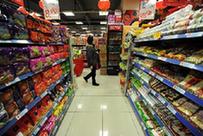Easing inflation fuels policy adjustment predictions
-
- Xinhua, January 13, 2012
|

|
|
A customer is seen in a supermarket in Hangzhou, capital of east China's Zhejiang Province, Jan. 12, 2012. China's National Bureau of Statistics (NBS) said Thursday that the country's CPI rose 4.1 percent year on year in December of 2011 and it grew 5.4 percent on year for the whole 2011. [Xinhua] |
A December decrease in China's inflation has fueled widespread guesses about policy loosening to spur the slowing economy, although analysts believe that significant easing is unlikely, as inflationary pressures remain.
The full-year inflation figure for 2011 was still up 5.4 percent from the previous year and well above the government's full-year control target of 4 percent, the National Bureau of Statistics (NBS) said in a statement on its website.
"Although the current inflation figure has eased, the country's monetary polices will not shift toward loosening, but will remain stable," said Zuo Xiaolei, chief economist at Galaxy Securities.
EASING PRESSURES
The growth of the country's consumer price index (CPI), a main gauge of inflation, eased to a 15-month low of 4.1 percent in December amid accumulative government tightening measures, the NBS said Thursday.
The country's inflation rate hit a 37-month high of 6.5 percent in July before dropping to 6.2 percent in August, 6.1 percent in September, 5.5 percent in October and 4.2 percent in November, according to the NBS data.
The NBS attributed the decline in CPI growth to falling non-food prices. Non-food prices rose 1.9 percent from a year earlier, but dropped 0.1 percent from November to December.
In the non-food category, the cost of living dipped 0.2 percent in December, while prices for entertainment, educational and cultural items and services dropped 0.3 percent.
Meanwhile, food prices, which account for nearly one-third of the basket of goods used to calculate the CPI, went up 9.1 percent year-on-year and 1.2 percent month-on-month in December.
The NBS said a carryover effect from last year phased out in December, meaning that this month's year-on-year increase in CPI growth was created entirely by new price rises.
The increases in food prices were mainly caused by the upcoming Spring Festival holiday, as well as weather- and transportation-related factors, Wang said.
The Producer Price Index, a major measure of inflation at the wholesale level, also suggested subdued inflationary pressures for the country. It rose 1.7 percent year-on-year in December, weakening from 2.7 percent a month earlier.
Although divided on whether consumer prices will retreat rapidly or remain at high levels, analysts agreed that the CPI growth has not yet reached a safe range.
"The first two months of the year will see a further retreat in the growth of consumer prices, but the volatility of international commodity prices, caused by geopolitical factors, will form new imported inflationary pressures," Wang said.
Meanwhile, domestic factors, including rising agricultural production, resources, land and labor costs, will push up consumer prices in the mid- to long-term, said Lian Ping, chief economist at the Bank of Communications.
Lian said the CPI will rise by 2.7 percent to 3.3 percent year-on-year in 2012, while Liu Ligang, director of the economic research department of ANZ Greater China, expects the full-year CPI to hit 4 percent.
MORE ROOM FOR POLICY FINE-TUNING
"The fact that the government failed to meet its target indicates that the country still faces mild inflationary pressures in the mid- and long-term," said Wang Jun, an analyst with the China Center for International Economic Exchanges.
China made controlling prices a top priority last year and implemented a series of measures to address the issue, including tightening its monetary policies, cracking down on speculation, increasing food supplies and reducing circulation costs.
The economy has been slowing as a result of government macroeconomic controls and shrinking external demand. China's GDP grew 9.1 percent year-on-year in the third quarter of 2011, down from 9.5 percent in the second quarter and 9.7 percent in the first quarter.
While further policy tightening is unlikely under current circumstances, analysts also ruled out the possibility of dramatic easing moves.
"Since inflationary pressures remain in the mid- and long-term and a 'hard landing' is unlikely to happen, there is no need for significant policy adjustments," Lian said.
Lian's remarks echoed the country's stance, stated at the recently concluded central economic work conference. The government said it will preset or fine-tune its monetary policy in line with economic changes, indicating its intent to stabilize growth while avoiding price rebounds.
The easing inflation has provided room for the government to take measures to prevent an economic plunge. Liu said the country's central bank will cut banks' reserve requirement ratio (RRR) before Spring Festival and make another two cuts in the first half of the year in an effort to ease the credit crunch among Chinese firms.
The People's Bank of China lowered the RRR by 50 basis points in December, its first cut in nearly three years.
主站蜘蛛池模板:
bt天堂资源在线种子|
久久综合九色综合91|
看一级毛片**直播在线|
国产亚洲欧美另类一区二区三区|
在线日本妇人成熟|
国模沟沟冒白浆视频福利|
yy111111影院理论大片|
把水管开水放b里是什么感觉|
久久精品亚洲日本波多野结衣|
欧美丰满熟妇XXXX性大屁股|
亚洲欧美高清在线|
狂野欧美激情性xxxx在线观看|
奶大灬舒服灬太大了一进一出|
久久99精品久久久久久hb无码|
日韩精品专区在线影院重磅|
亚洲人成人一区二区三区|
欧美激情xxxx性bbbb|
亚洲色中文字幕在线播放|
男朋友说我要冲你是什么意思|
四虎亚洲国产成人久久精品|
2022天天躁夜夜燥|
在线免费观看毛片网站|
jizzz护士|
好男人看视频免费2019中文|
两个体校校草被c出水|
把美女日出白浆|
久久91精品综合国产首页|
日本理论片2828理论片|
久久精品一区二区三区资源网|
最近免费观看高清韩国日本大全
|
久久久亚洲av波多野结衣|
日韩欧美三级在线|
久久精品女人毛片国产|
最新中文字幕av专区|
亚洲av日韩av无码av|
欧美一级片在线观看|
亚洲丶国产丶欧美一区二区三区|
欧美天堂在线观看|
亚洲剧情在线观看|
欧美va天堂在线电影|
亚洲av无码不卡一区二区三区|
